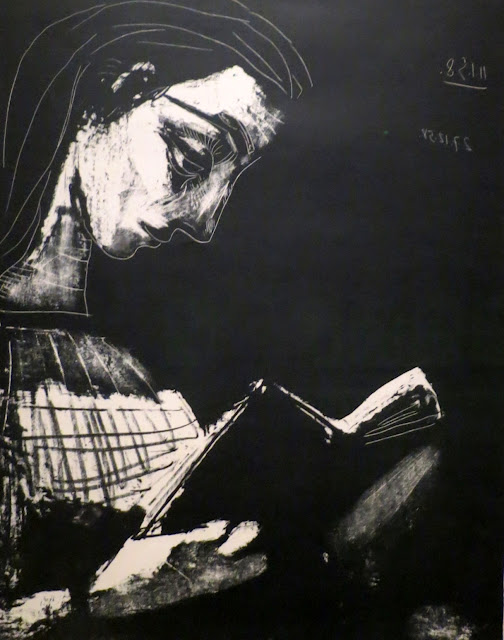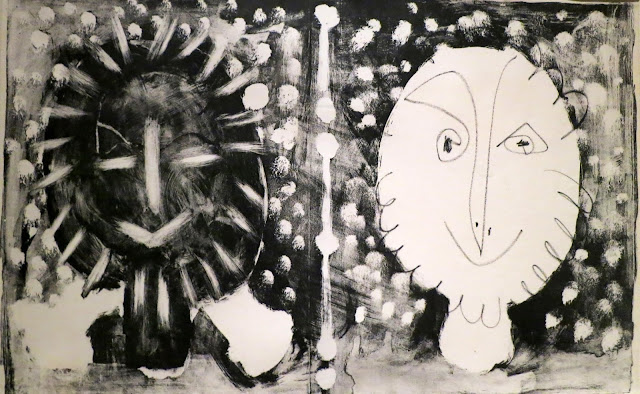Picasso on Paper
at Compton Verney, Warwickshire.
More than 70 works dating from the 1920s to the 1960s trace Picasso's experiments in various media including etching, lithography, aquatint and linocut, on a variety of subjects.
Picasso talked of printmaking as his way of 'writing fiction' and this is reflected in the recurrent themes of bullfighting, family and Greek mythology. He received no formal training in printmaking, but acquired his skills on his own volition and in very close collaboration with master printmakers often breaking the rule book to great success.
Jacqueline Reading, 1958, (lithograph)
Paloma an Claude, 1950, (lithograph)
Picasso created this lithograph using his fingers. Not having any lithographic tools available at that moment, he created the image by thinning solidified ink with water and dipping his fingers in the liquid.
Book Cover, Vol. I, 1949, (lithograph)
Motherhood, 1924, (etching)
Figure, 1929, (lithograph)
Lobster and Fish, 1949, (lithograph)
Francoise, (lithograph)
This is one of eleven images Picasso made of Jacqueline in one day. In each portrait he included a tiny mole under her left eye and drew her right eyebrow in the form of a circumflex accent.
The exhibition also featured a number of poems that Picasso wrote. 'It wasn't until he was 54, contending with impasses in his visual art and personal life, that Picasso finally tried his hand at poetry himself. The result was a torrent of words that continued for nearly 50 years', writes Rob Woodward in the Guardian.
The work owes a great deal to his training as a painter, in that he eschewed the typical musical foundation of verse (Picasso never cared much for music) and treated his words like brushstrokes. Additionally, taking cues from his own cubist breakthroughs and surrealist notions a la Breton, he generally threw traditional notions of grammar, structure, and punctuation out the window, allowing him to create crowded, often daunting collages of images, ideas and emotions.
We were allowed to take a copy of one of his poems with us, and I have reproduced it below:
All the filthy jumble of the cacophony of the
dazzling lights, projected onto the ochre print of
the face filled with excrements of the huge drum
ringing out the crying clouds, wound opening
showing its teeth in the opening of the well
enveloping the flesh which melts the bones
hammered into the clay and the untidy hair of her
braids, lifting her arms, the pieces of broken
windows stuck to the temples of the tick tock of
restless clocks of the seaweed and the signs and
the defeated curtains by the amorous blows of
perfumes and the painful groans of the crushed
flowers, exit the wheels, the hands parting the
water which stands on the table and the crumpled
music of the laundry calling
The exhibition is complemented by eight ceramics created in association with the Madoura pottery
near Antibes in Provence.











No comments:
Post a Comment